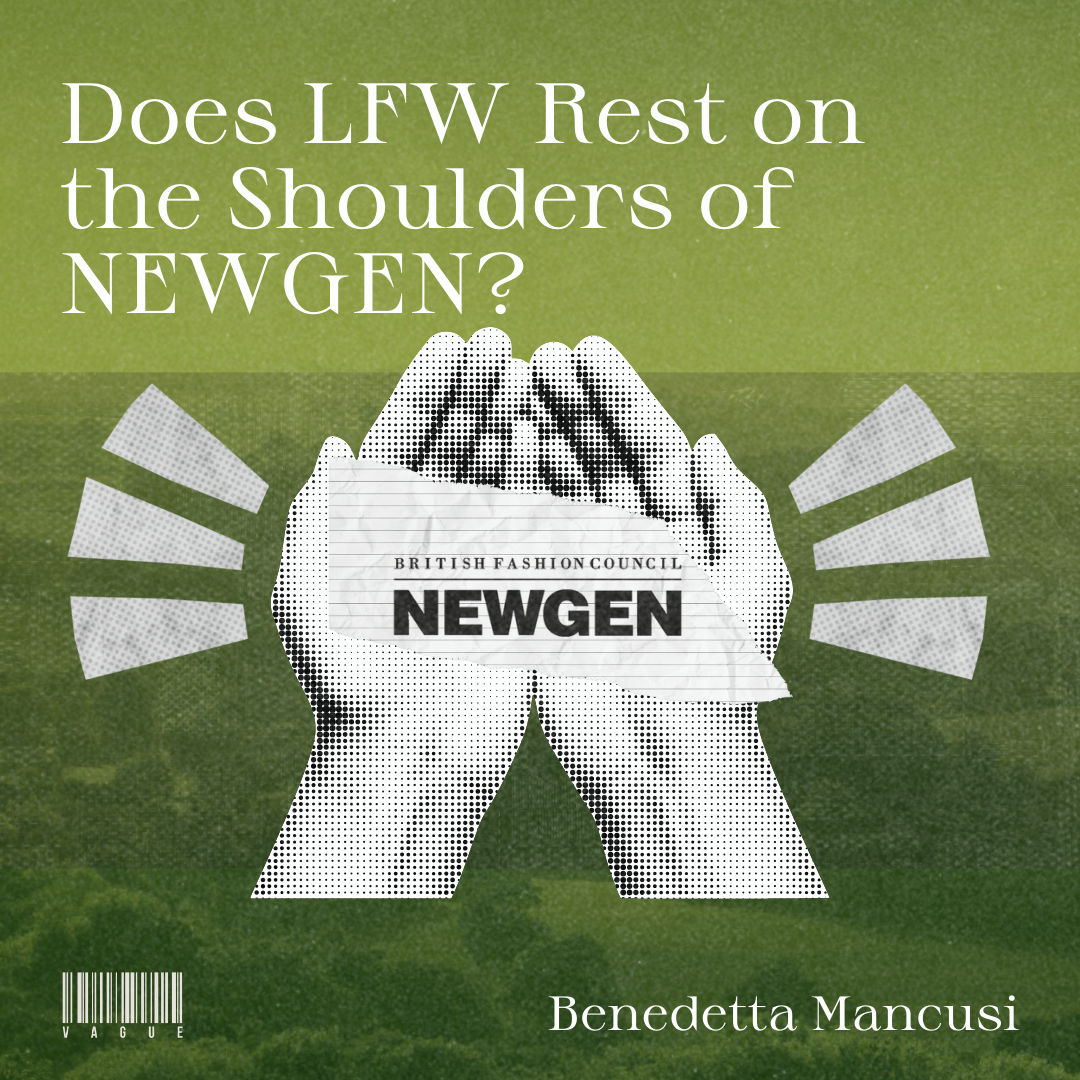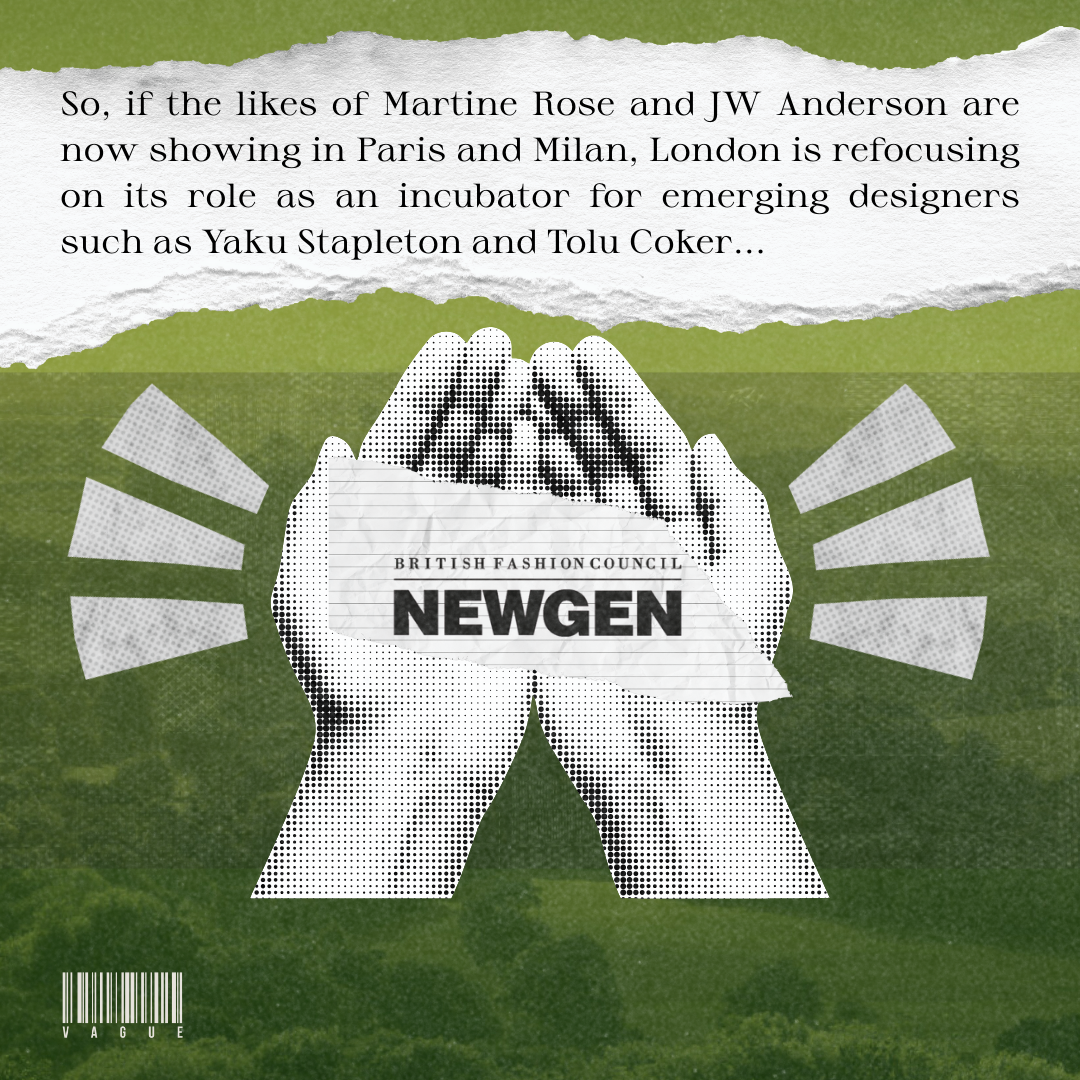Does LFW Rest on the Shoulders of NEWGEN?
London Fashion Week is being rebranded as fashion’s great incubator. VAGUE Resident Benedetta explains the challenges Laura Weir’s strategic repositioning still has yet to overcome.
This past season, the new British Fashion Council (BFC) CEO, Laura Weir, ushered in a new era of London Fashion Week. With “20% more designers on schedule than last September,” she embarked on a mission to put London back on the global fashion map. And, make no mistake, fashion week is not just about the spectacle: fashion week is a marketing campaign, the most front-facing product of an industry that contributes over £67 billion to the UK economy. Not to mention, it employs countless people, from pattern cutters to make-up artists and sound designers. It shouts: We, British designers, are here; we’re creating and these are our stories.
Unfortunately, in recent years London has fallen behind Paris and Milan in the fashion week hierarchy. The rippling effects of Brexit have been deeply felt, and the UK capital is still recovering, still trying to prove it can stay relevant. Fashion Roundtable CEO Tamara Cincik famously called Brexit “a gift to France,” with Paris becoming the place where fashion now thrives; where hotels burst with buyers and press. After Brexit, France courted the industry. And it worked. Gradually, inexorably, international investors chose to do their high-end business in Paris, where it’s cheaper and easier. Many of Britain’s big names, from Vivienne Westwood to JW Anderson (Dior’s new Creative Director), have also shown overseas.
This is the complex landscape Laura Weir inherited, and it’s no small challenge. Yet as someone with inside-out knowledge of the industry, she appears well-positioned to tackle it head-on. From the outset, she has shown optimism and a clear plan to turn things around. A plan that says, “Chin up, we’re moving forward. We’re investing in new talent.”
And new talent has indeed shown up.
“After Brexit, France courted the industry. And it worked.”
£2 million has been invested in the well-established NEWGEN programme — once backed by European ERDF subsidies — which aims to provide “the best emerging fashion design talent” with showcasing opportunities, mentoring, and grants. So, if the likes of Martine Rose and JW Anderson are now showing in Paris and Milan, London is refocusing on its role as an incubator for emerging designers such as Yaku Stapleton and Tolu Coker: personal, raw storytelling that feels distinctly of the British capital.
For attendees, the ritual remains largely the same: queueing outside Protein Studios in East London or a posh hotel in Central, social media snaps flying, the front row soaking it all in. The adrenaline spikes as a show begins, and journalists try to sneak backstage to catch a designer or model for a quote. Some shows were genuinely entertaining, thanks to designers’ impressive attention to detail. From trinkets and goodie bags to immersive storytelling that rivals, perhaps even surpassing, the greatest.
One thing about this past London Fashion Week: it did not lack originality, and it most certainly did not lack talent. Highlights included YAKU’s theatrical runway, where each outfit represented a member of the designer’s family, and Dreaming Eli’s MY NAME IS AMORE collection — an ode to romantic love born from self-love, a surrender to another after having surrendered to oneself. These are just two examples from a season where buzz was built and sustained by fresh voices. Impeccable curation and intentionality coexisted with vulnerability and risk-taking. Daring and hyped, for good reason.
So, London is striving to be the platform where brilliant careers can take off. But what happens once fashion week is over? What happens after those careers take flight? And what about the designers who aren’t selected for NEWGEN funding? If runway visibility offers great opportunities and excitement, many designers return to studios facing unpaid invoices, unstable production, and little access to financing.
The fashion industry, in fact, has always been notoriously tough to navigate for emerging designers. For starters, most fashion schools tend to nurture creativity more than business acumen. Many promising brands never scale due to lack of investment or distribution channels. Post-Brexit, they also face new barriers to entering European markets; not to mention the complexities of IP law, as unregistered design rights are no longer automatically protected across the EU. It’s little wonder that so much talent has been lost to burnout, precarity, or emigration abroad.
Even NEWGEN, while offering visibility and real opportunity, has its limits. Some designers have complained that funding doesn’t cover all of the costs associated with extensive showcasing. According to the June 2025 Final Evaluation Report of the programme, “some industry stakeholders noted that while NEWGEN helps designers boost their sales, this is limited by the current economic climate, as well as a focus on showcasing over the commerciality of the programme overall.” Among the improvements suggested by both designers and stakeholders were: greater clarity on fund allocation, a stronger commercial focus during fashion week, and more structured support to develop business acumen, not just creative visibility.
The lack of a strong structure in place has also affected the designers showing this season. As Zofia Zwieglinska notes for Glossy, “Unlike in Milan or Paris, London offers no structured opportunities to view collections after the show.” This means that if you miss a show, or can’t sit front row (which is a whole other story in itself on who does get to sit front row), then that designer will have missed an opportunity to form a bond with a journalist, content creator, or a buyer.
“...while NEWGEN helps designers boost their sales, this is limited by the current economic climate, as well as a focus on showcasing over the commerciality of the programme overall.”
London Fashion Week this past season suggested hope through creativity, curation, energy. Under Laura Weir, something has shifted. But fashion weeks alone cannot guarantee systemic revival. The real measure will be whether, in five years, Yaku Stapleton and Tolu Coker have become stable global brands; whether the pipeline — from education to infrastructure to market — has strengthened; whether British fashion becomes resilient to economic shocks, trade frictions, and sustainability demands.
Perhaps London will never rival Paris or Milan in luxury. And perhaps it doesn’t need to. Its true strength, as seen this season, lies in its cultural edge: diversity, daring aesthetics, and powerful storytelling. If London can combine that edge with structural investment and scale, it can carve a distinct niche. A capital of experimentation fuelled by sustainable, inclusive growth.
Ultimately, aligning narrative with financial structures and curation with an ethical supply system will be essential. The creation of sustainable, viable careers will be the real test of success.
credits
words — benedetta mancusi
design — karina so.


